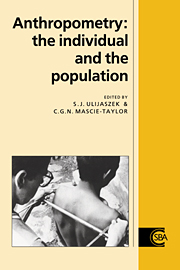Book contents
- Frontmatter
- Contents
- List of contributors
- Preface
- Acknowledgements
- 1 The place of anthropometry in human biology
- 2 Asymmetry and growth
- 3 Intra- and inter-observer error in anthropometric measurement
- 4 Statistical issues in anthropometry
- 5 Statistical constructs of human growth: new growth charts for old
- 6 Growth monitoring and growth cyclicities in developed countries
- 7 Growth monitoring, screening and surveillance in developing countries
- 8 Variability in adult body size: uses in defining the limits of human survival
- 9 Anthropometry and body composition
- 10 Anthropometry and physical performance
- 11 Anthropometry, strength and motor fitness
- 12 Anthropometry in the US armed forces
- Index
9 - Anthropometry and body composition
Published online by Cambridge University Press: 19 November 2009
- Frontmatter
- Contents
- List of contributors
- Preface
- Acknowledgements
- 1 The place of anthropometry in human biology
- 2 Asymmetry and growth
- 3 Intra- and inter-observer error in anthropometric measurement
- 4 Statistical issues in anthropometry
- 5 Statistical constructs of human growth: new growth charts for old
- 6 Growth monitoring and growth cyclicities in developed countries
- 7 Growth monitoring, screening and surveillance in developing countries
- 8 Variability in adult body size: uses in defining the limits of human survival
- 9 Anthropometry and body composition
- 10 Anthropometry and physical performance
- 11 Anthropometry, strength and motor fitness
- 12 Anthropometry in the US armed forces
- Index
Summary
Introduction
Humans have been concerned with the composition of the human body for many centuries. Since ca. 440 BC, when Hippocrates postulated his ideas of the four constituents of man, we have come a long way in our understanding of the composition of the body. Most current techniques might be regarded, however, as a retrograde step as usually the body is split into two components, fat-free mass (FFM) and fat mass (FM). Describing the body as two compartments began in earnest when a number of workers produced equations relating the specific gravity or density of the body to the percentage of fat within it (Rathbun & Pace, 1945; Siri, 1956). The principle on which these equations are based was derived hundreds of years ago by Archimedes, namely, that if a body has two components of different densities, the proportion of the components can be calculated from the density of the body. Using these and other equations a great deal of work has been done to assess the percentage of the body which is fat, and hence calculate body FM. Much of the early work involved US Navy personnel (Behnke, Feen & Welham, 1942; Morales et al., 1945). Another measure, subcutaneous ‘fatness’, has been assessed by using skinfold callipers, the skinfold measurements often being related to total body fat measurements. More complex techniques are laboratory-based, while anthropometric techniques are used to assess body composition under field conditions.
Measurement of body composition in children offers a number of problems not necessarily encountered in studies of adults. This chapter concentrates on the difficulty of using anthropometry to assess body composition in children, and presents a possible new anthropometric tool.
- Type
- Chapter
- Information
- AnthropometryThe Individual and the Population, pp. 130 - 140Publisher: Cambridge University PressPrint publication year: 1994
- 3
- Cited by



